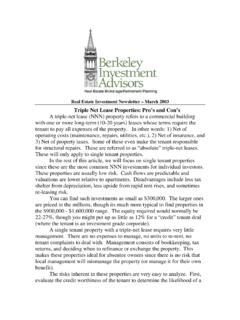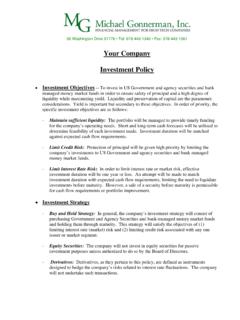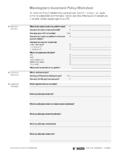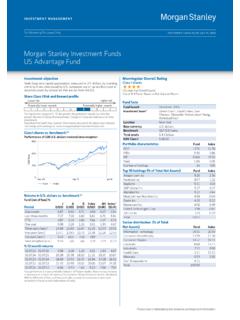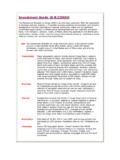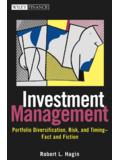Transcription of AGRICULTURAL INVESTMENT FUNDS for …
1 AGRICULTURAL INVESTMENT FUNDS . for developing countries . AGRICULTURAL INVESTMENT FUNDS . for developing countries . Calvin Miller Sylvia Richter Patrick McNellis Nomathemba Mhlanga FOOD AND AGRICULTURE ORGANIZATION OF THE UNITED NATIONS. Rome, 2010. The designations employed and the presentation of material in this information product do not imply the expression of any opinion whatsoever on the part of the Food and Agriculture Organization of the United Nations (FAO) concerning the legal or development status of any country, territory, city or area or of its authorities, or concerning the delimitation of its frontiers or boundaries. The mention of specific companies or products of manufacturers, whether or not these have been patented, does not imply that these have been endorsed or recommended by FAO in preference to others of a similar nature that are not mentioned. The views expressed in this information product are those of the author(s) and do not necessarily reflect the views of FAO.
2 All rights reserved. Reproduction and dissemination of material in this information product for educational or other non-commercial purposes are authorized without any prior written permission from the copyright holders provided the source is fully acknowledged. Reproduction of material in this information product for resale or other commercial purposes is prohibited without written permission of the copyright holders. Applications for such permission should be addressed to the Chief, Electronic Publishing Policy and Support Branch, Communication Division, FAO, Viale delle Terme di Caracalla, 00153 Rome, Italy or by e-mail to FAO 2010. AGRICULTURAL INVESTMENT FUNDS for developing countries iii Contents PREFACE vii ACKNOWLEDGEMENTS ix ACRONYMS AND ABBREVIATIONS xi GLOSSARY xiii EXECUTIVE SUMMARY xv 1. THE ROLE OF INVESTMENT FUNDS IN AGRICULTURE 1. Understanding AGRICULTURAL INVESTMENT FUNDS and their growth 2.
3 INVESTMENT fund research study 3. The importance of agriculture for development 6. The investor's perspective on investments in agriculture 9. Capital needs and the role of investments in agriculture 14. 2. STOCK-TAKING OF AGRICULTURAL INVESTMENT FUNDS 19. General characteristics of INVESTMENT FUNDS 19. Trends regarding the set-up of AGRICULTURAL INVESTMENT FUNDS 21. Geographic distribution and outreach of selected FUNDS 22. Size of selected INVESTMENT FUNDS (capital base) 23. Shareholder structure of the selected FUNDS 27. Assets management of selected FUNDS 28. Target groups served by the identified INVESTMENT FUNDS 28. Organization and set-up of AGRICULTURAL INVESTMENT FUNDS 30. The INVESTMENT process 30. The role of technical assistance 31. Expected and actual financial performance 32. INVESTMENT fund impact 34. Principal issues, constraints and opportunities 35. 3. OPERATIONS, PERFORMANCE AND COMPARATIVE ANALYSIS.
4 OF AGRICULTURAL INVESTMENT FUNDS 37. Overview of selected case studies 37. AGRICULTURAL FUNDS compared to other FUNDS 43. The effects of the global food and financial crises 47. iv Contents 4. CONCLUSIONS AND RECOMMENDATIONS 53. Summary of findings 53. Recommendations for setting up AGRICULTURAL INVESTMENT FUNDS 54. Policy recommendations 56. Recommendations for further research 58. REFERENCES 61. ANNEXES. Annex 1. Management Company Case Study Small Enterprise Assistance FUNDS 63. Annex 2. Case Study Georgia Regional Development fund 73. Annex 3. Case Study Actis Africa Agribusiness fund 91. Annex 4. Case Study Agribusiness Partners International fund 105. Annex 5. Case Study Sustainable Agriculture Guarantee fund 111. Annex 6. Case Study Rural Impulse fund 123. Annex 7. Case Study African AGRICULTURAL Capital 133. Annex 8. INVESTMENT fund summaries overview 145. Annex 9. INVESTMENT fund summaries FUNDS , sectors, instruments and types 165.
5 BOXES. Box 1 INVESTMENT by the Georgia Regional Development fund 's in Dogan 1. Box 2 INVESTMENT by the Agribusiness Partners International fund in Chicken Kingdom 2. TABLES. Table 1 Overview of AGRICULTURAL INVESTMENT FUNDS 5. Table 2 . The INVESTMENT sector: agriculture and agribusiness 21. Table 3. Capital base of selected AGRICULTURAL INVESTMENT FUNDS 24. Table 4. Overview of current investments the Georgia Regional Development fund portfolio 79. Table 5. Projected growth rates for development indicators . the Georgia Regional Development fund portfolio 82. Table 6. Impact of INVESTMENT on workforce and suppliers 82. Table 7. Current status overview of projects funded by Actis Africa Agribusiness fund 31 101. Table 8. Overview of investors of the Rural Impulse fund 125. Table 9. Terms and conditions of the Rural Impulse fund 127. Table 10. Performance of the partner MFIs of the Rural Impulse fund 130. FIGURES.
6 Figure 1. Stakeholders influencing the AGRICULTURAL value chain 7. Figure 2. AGRICULTURAL stakeholders' risks and opportunities 8. Figure 3. The development of food prices and stocks (June 2006 April 2009) 12. Figure 4. The rural finance gap and the missing middle 14. Figure 5. Rising trend in setting up AGRICULTURAL INVESTMENT FUNDS 22. Figure 6. Geographic distribution of AGRICULTURAL INVESTMENT FUNDS 22. Figure 7. Distribution of FUNDS according to geographic outreach 23. AGRICULTURAL INVESTMENT FUNDS for developing countries v Figure 8. Distribution of AGRICULTURAL INVESTMENT FUNDS according to capital base 24. Figure 9. Overview of operations of the Georgia Regional Development fund 31. Figure 10. Distribution of AGRICULTURAL INVESTMENT FUNDS by return expectations 33. Figure 11. Development of oil and food prices (January 2009 May 2009) 48. Figure 12. Global gross domestic product (GDP) growth per country groups (2007 09) 50.
7 Figure 13. SEAF industry portfolio breakdown 67. Figure 14. Organizational chart of the Georgia Regional Development fund 75. Figure 15. Overview of INVESTMENT decision making in the Actis Africa Agribusiness fund 93. Figure 16. Indicative diagram of financial flows and support services of the Actis Africa Agribusiness fund 95. Figure 17. The management and governance structure of the Sustainable Agriculture Guarantee fund 113. Figure 18. The guarantee structure of the Sustainable Agriculture Guarantee fund 117. Figure 19. Management and governance structure of the Rural Impulse fund 124. Figure 20. Geographic distribution of investments of the Rural Impulse fund 126. Figure 21. INVESTMENT portfolio according to INVESTMENT instruments of the Rural Impulse fund 127. Figure 22. African AGRICULTURAL Capital Composition of the Board of Directors 135. AGRICULTURAL INVESTMENT FUNDS for developing countries vii Preface AGRICULTURAL INVESTMENT FUNDS , which have experienced significant growth in numbers and volume in recent years, have underscored public and private sectors' interest to help address the resource constraints for achieving food security.
8 Moreover, the growing attractiveness of AGRICULTURAL INVESTMENT projects as profitable business ventures has played a role in the emergence and growth of such FUNDS , especially in light of higher AGRICULTURAL prices and improved business climates that favour longer-term investments. This publication provides insight into the nature and operations of these FUNDS and draws lessons for development agencies, governments and investors. It was developed from AGRICULTURAL INVESTMENT FUNDS for developing countries (October 2009), a research study undertaken as a joint collaboration of ConCap Connective Capital (ConCap) and the Food and Agriculture Organization of the United Nations (FAO) in order to better understand the growth and potential of agriculture and agribusiness INVESTMENT FUNDS . It included a stocktaking analysis of AGRICULTURAL INVESTMENT FUNDS as well as case studies of distinct FUNDS and fund management structures.
9 This publication is enhanced with a complementary analysis of AGRICULTURAL FUNDS in the broader context of non- AGRICULTURAL INVESTMENT FUNDS and experiences, and an analysis of the effects of the food price increases of 2008 and the financial and economic crisis in 2008. and 2009. This publication outlines the importance of connecting less developed financial markets around the world with international investors, and in promoting joint efforts by the public and private sectors. The INVESTMENT study and publication by the Rural Infrastructure and Agro-Industry Division (AGS) of FAO form part of a larger analysis and work on AGRICULTURAL INVESTMENT by the Division and other parts of the Organization. AGRICULTURAL INVESTMENT FUNDS for developing countries ix Acknowledgements The authors would like to thank all those who generously shared their insights into their funding operations. Special thanks go to those who provided significant contributions in the development of the case studies: Mildred Callear, Stephanie Komsa and Katherine H.
10 Wheeler (Small Enterprise Assistance fund and Georgia Rural Development fund ). Keith Alexander (Actis Africa Agribusiness fund ). Patrick Oketa (African AGRICULTURAL Capital). Marissa Blankenship (Rural Impulse fund , Incofin). Ellen Bogers (Sustainable AGRICULTURAL Guarantee fund , Rabobank International). The authors would also like to thank Sylvia Wisniwski, Marco Kaiser and Diego Staff (ConCap Connective Capital) and Elmar Benjie Panahon (Frankfurt School of Finance &. Management) for their continuous support during the different stages of developing and writing the original study on which this publication was developed. Special thanks are due to FAO colleagues, Ivana Gegenbauer for her contributions to this publication, Doyle Baker, Prasun Das, Andrew Shepherd, Ake Olofsson and Divine Njie for their insightful reviews, to Barbara Hall for her support in editing, and to Marianne Sinko for layout and graphics.










